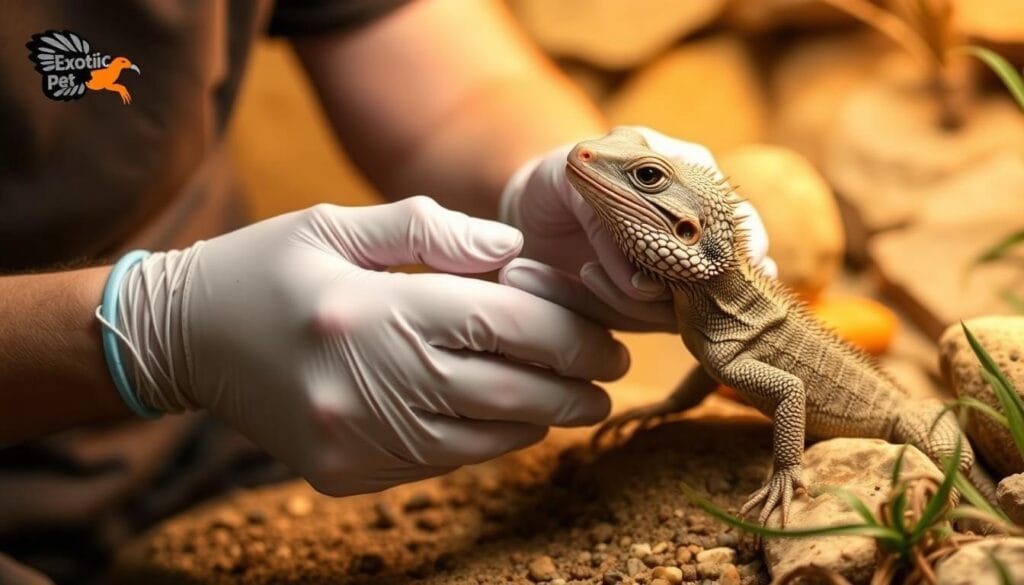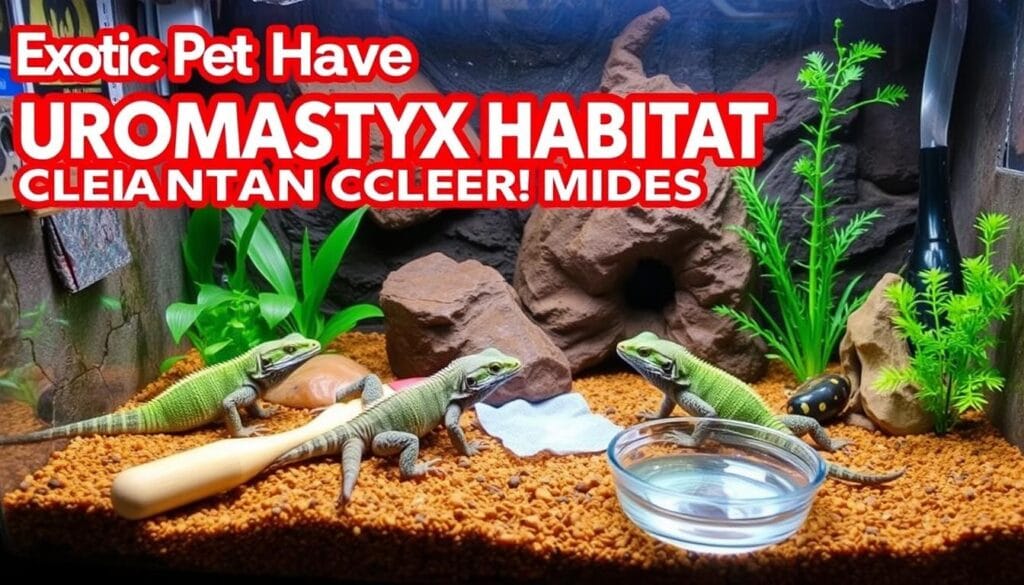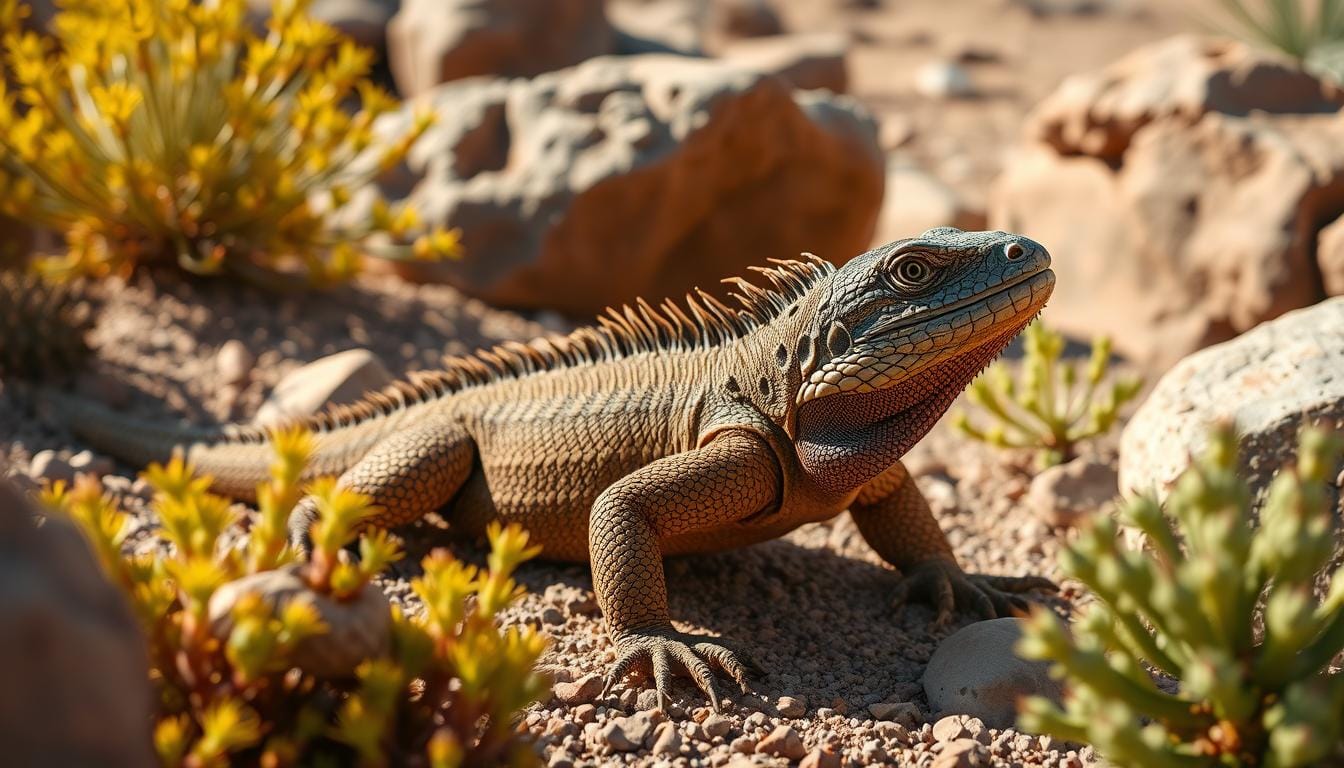Ever wondered about caring for a desert reptile that looks like a dragon? Uromastyx lizards are amazing creatures that bring the desert to your home. They have captured the hearts of many with their unique looks and behaviors.
The Uromastyx world is full of diversity and interest. With about 20 species, they range from 9 to 30 inches long. These herbivorous reptiles come from a wide area, from Morocco to India and Pakistan. Whether you’re new or experienced, a Uromastyx makes a special pet.
Getting a Uromastyx is more than having a pet. It’s starting an adventure to learn about a remarkable creature. These lizards show nature’s incredible ability to adapt to tough environments.
Table of Contents
Introduction to Uromastyx
Explore the world of Uromastyx species, unique lizards loved by reptile fans everywhere. These amazing creatures live in the dry lands of North Africa and the Middle East. There are about 20 different types, each with special ways to survive in the desert.
What Are Uromastyx Lizards?
Uromastyx lizards, also called spiny-tailed lizards, are plant-eating reptiles. They have strong bodies, spiny tails, and can live in very hot deserts. These traits make them stand out from other lizards.
- Typical adult size ranges from 10-16 inches
- Average lifespan: 15-25 years
- Primarily found in rocky desert landscapes
Natural Habitat and Behaviors
Uromastyx species have learned to survive in tough desert environments. They use their specialized tails to defend themselves. They also have special ways to handle very hot and cold temperatures.
| Habitat Characteristic | Details |
|---|---|
| Native Region | North Africa and Middle East |
| Temperature Tolerance | 70-120°F |
| Preferred Terrain | Rocky desert, sandy areas |
| Diet Composition | 90% Vegetables, 10% Fruits |
Learning about Uromastyx species can help you make a great home for them. They eat plants, interact with each other in special ways, and are very good at adapting. These traits make them great pets for those who really love reptiles.
Choosing the Right Uromastyx Species
Choosing the right Uromastyx for your home needs careful thought. You must consider their size, lifespan, and specific needs. With over 15 species worldwide, each has its own traits and care needs.
Learning about Uromastyx lizards helps you pick the best one for you. This depends on your experience and the space you have.
Popular Species Comparison
| Species | Size Range | Average Lifespan | Difficulty Level |
|---|---|---|---|
| Egyptian Uromastyx | Up to 30 inches | 20-25 years | Intermediate |
| Ornate Uromastyx | 12-14 inches | 15-20 years | Beginner |
| Mali Uromastyx | 10-15 inches | 18-22 years | Beginner |
| Saharan Uromastyx | 11-13 inches | 15-20 years | Intermediate |
Key Considerations for Species Selection
- Evaluate your experience level with reptile care
- Consider the available space for habitat setup
- Assess the specific Uromastyx size requirements
- Understand the long-term commitment of Uromastyx lifespan
The Ornate Uromastyx is great for beginners. It has bright colors and a small size. It’s also calm, making it perfect for those new to reptiles.
Remember, each Uromastyx needs special care. Things like diet, temperature, and habitat design differ between species. Knowing these needs helps keep your pet healthy and happy.
Setting Up the Perfect Habitat
Creating a great home for your Uromastyx is key to their well-being. These desert lizards need a space that feels like home. It should have the right conditions.
Terrarium Size and Design
Planning your Uromastyx’s home is important. They need a space that’s at least 4 feet long, 2 feet wide, and 2 feet high. Bigger lizards might need even more room.
Think about these things when setting up their home:
- Minimum recommended length: 48 inches
- Width: At least 24 inches
- Height: 24 inches or taller
Substrate and Habitat Enrichment
Choosing the right substrate is vital. Uromastyx love to dig, so they need 4-6 inches of it. Good options include:
- Fine sand
- Reptile-specific desert substrate
- Mixture of sand and soil
Temperature and Lighting Requirements
A good heat lamp is a must for the right temperature. You’ll need a temperature range like this:
- Basking spot: 100-115°F
- Warm side: 100°F
- Cool side: 80-85°F
- Nighttime temperature: 70-75°F
Use a top-notch UVB lamp and change it every 6 months. This helps with vitamin D3. Keep humidity low, between 20-35%, to match their desert home.
Additional Habitat Considerations
Add rocks, shallow hiding spots, and simple decorations. This lets your Uromastyx explore and feel safe. Stay away from too many decorations that could mess with their temperature.
Feeding Your Uromastyx
Knowing what to feed your Uromastyx is key to keeping them healthy. These reptiles mainly eat plants, which is different from many other pets. They need a special diet to stay well.
Nutritional Needs: Herbivorous Diet Essentials
Your Uromastyx needs mostly plants in their diet, 70-90%. This is vital for their health and long life. Learning how to feed them right is important.
Recommended Food Items
- Leafy greens (primary diet component)
- Vegetables rich in nutrients
- Occasional small amounts of seeds
- Carotenoid-rich foods like shredded carrots
Avoiding Common Feeding Mistakes
| Feeding Recommendation | Details |
|---|---|
| Calcium Supplementation | Dust food with calcium powder twice weekly |
| Fruit Intake | Limit to 5-10% of total diet |
| Feeding Frequency | 5-6 meals per week for adults, daily for young lizards |
Watching what your Uromastyx eats is very important. Young ones need to eat more often, while adults should have smaller portions. Stay away from foods with oxalates and goitrogens to keep them healthy.
Feeding your Uromastyx right helps them live up to 30 years. This way, they stay active and healthy for a long time.
Health and Wellness
Keeping your Uromastyx healthy is very important. These lizards need careful watching and early health care to live long, happy lives. Knowing about health problems helps you care for your reptile friend better.
Recognizing Signs of Illness
Spotting health issues early is key to good Uromastyx care. Look out for these signs:
- Lethargy or decreased activity levels
- Changes in appetite or weight loss
- Unusual skin discoloration
- Respiratory difficulties
- Abnormal droppings
Regular Health Checkups
Make sure to take your Uromastyx to a reptile vet every year. These visits help catch health problems early and keep your Uromastyx healthy.
Common Ailments and Treatments
Uromastyx face several health issues that need quick action:
| Health Issue | Symptoms | Prevention |
|---|---|---|
| Metabolic Bone Disease | Soft shells, deformities | Proper calcium supplementation |
| Respiratory Infections | Wheezing, mucus discharge | Maintain appropriate humidity |
| Parasitic Infections | Weight loss, lethargy | Regular fecal examinations |
A healthy Uromastyx has clear eyes, the right weight, and is active. Watching them closely and taking care of their health is key to their long, happy life.
Social Behavior and Interaction
Knowing how Uromastyx lizards act is key for good pet care. These reptiles show unique behaviors that affect how they interact with people and other lizards.
Are Uromastyx Social Animals?
Uromastyx lizards are not very social. Most like to be alone. Even though they can live together sometimes, experts say it’s best to keep them apart. This helps avoid fights and keeps them stress-free.
- Minimize territorial disputes
- Reduce stress for individual lizards
- Prevent possible injury
Handling and Bonding Tips
Building a bond with your Uromastyx lizard takes time and patience. They have their own personalities and might need time to get used to being around people.
| Handling Technique | Recommendation |
|---|---|
| Frequency | Start with short, gentle interactions |
| Approach | Move slowly and predictably |
| Support | Always support entire body during handling |
Remember, every Uromastyx lizard is different. Some may get very calm with regular, gentle handling. Others might stay a bit more to themselves.

- Regular, predictable interactions
- Maintaining calm body language
- Offering food during handling sessions
- Respecting the lizard’s personal space
By understanding and respecting your Uromastyx lizard’s natural ways, you can create a strong bond. This will make both your lives richer.
Breeding Uromastyx
Breeding Uromastyx needs special knowledge and careful planning. These interesting lizards have unique needs for breeding. They require precise environmental conditions and expert care.
Breeding Requirements and Conditions
Before you start breeding Uromastyx, you need to know a few key things:
- Uromastyx are ready to breed at about 3 years old
- The best breeding temperature is between 75-95°F
- They need a cooling period of 2-3 months at 60-75°F
Caring for Hatchlings
Raising Uromastyx hatchlings needs a lot of attention. They need special care to grow healthy.
- Keep the temperature around 85-90°F
- Use UVB lighting with 10-12% output
- Give them finely chopped dark leafy greens
- Handle them as little as possible to avoid stress
Successful Uromastyx breeding means knowing their specific needs. With the right preparation and patience, you can help these amazing reptiles thrive and reproduce in captivity.
Cleaning and Maintenance
Keeping your Uromastyx’s habitat clean is key to their health and happiness. A clean space helps avoid sickness, lowers stress, and boosts their overall health.
Habitat Cleaning Schedule
Your Uromastyx’s home needs regular, detailed care. Create a schedule for the best living conditions:
- Daily spot-cleaning of waste and uneaten food
- Weekly substrate inspection and partial replacement
- Monthly deep cleaning of entire enclosure
- Quarterly complete substrate replacement
Maintaining Proper Humidity Levels
Uromastyx habitats need very low humidity. These desert lizards do best in dry air with humidity between 20-30%.
| Humidity Range | Impact on Uromastyx |
|---|---|
| Below 20% | Too dry, risk of dehydration |
| 20-30% | Best habitat conditions |
| Above 35% | High risk of respiratory infections |
Use a reliable hygrometer to check humidity levels often. Don’t mist or add extra moisture to their habitat.

Cleaning Best Practices
- Use reptile-safe disinfectants
- Remove all decorations during deep cleaning
- Sanitize water dishes regularly
- Inspect for signs of mold or bacterial growth
Pro tip: Always wash your hands before and after cleaning to prevent spreading germs.
Understanding Uromastyx Behavior
Exploring the world of Uromastyx lizards shows us their complex behavior. These reptiles use many ways to communicate. This helps us understand their mood and needs better.
Common Behavioral Characteristics
Uromastyx lizards are most active during the day. Their actions are greatly influenced by light and temperature. Knowing this helps us care for them better.
- Active during daytime hours
- Highly responsive to environmental changes
- Demonstrate distinct social and communication patterns
Interpreting Body Language
It’s important to understand your Uromastyx lizard’s body language. They use physical signals to show their feelings and comfort. This helps us build a strong bond with them.
| Behavior | Meaning |
|---|---|
| Head Bobbing | Territorial display or communication |
| Tail Wagging | Potential stress or defensive posture |
| Color Changes | Temperature regulation or emotional response |
Notice any changes in your Uromastyx lizard’s behavior. Quick color changes, unusual tiredness, or eating changes might mean health or stress issues.
Social Interaction Insights
Uromastyx lizards are not usually social. But, they can bond with their owners. This happens through gentle handling and regular routines.
- Prefer minimal direct handling
- Respond well to consistent care
- Can become more comfortable with patient interaction
There are 18-20 Uromastyx lizard species. Each one has its own behavior. Knowing these differences helps us care for our reptile friends better.
Essential Supplies for Uromastyx Care
Getting the right gear is key for taking care of Uromastyx. Whether you’re new to reptiles or have experience, the right supplies are vital. They help keep your Uromastyx healthy and happy.
Must-Have Equipment Checklist
Setting up a good home for your Uromastyx requires some important items. Here’s a list of what you’ll need:
- Large terrarium (minimum 4 feet in length)
- Uromastyx heat lamp with proper wattage
- UVB lighting fixture
- Digital thermometer and hygrometer
- Substrate appropriate for desert environments
- Shallow water dish
- Hiding spots and rocky decorations
Recommended Brands and Products
Choosing the right products for Uromastyx care is important. Here are some top picks:
| Product Category | Recommended Brand | Key Features |
|---|---|---|
| Uromastyx heat lamp | Zoo Med Repti Basking Spot Lamp | High-quality ceramic heating element |
| UVB Lighting | Arcadia Desert 12% UVB Lamp | Optimal spectrum for desert reptiles |
| Substrate | Zoo Med Excavator Clay Burrowing Substrate | Supports natural burrowing behavior |
| Thermometer | Vivosun Digital Thermometer | Accurate temperature monitoring |
When picking supplies for Uromastyx care, focus on quality and what’s best for your pet. The right choices will make a big difference in your Uromastyx’s life.
Frequently Asked Questions (FAQs)
Thinking about getting a Uromastyx? You might have lots of questions about these desert lizards. It’s key to know how to care for them to keep them happy and healthy.
People often ask about what to feed them, how to set up their habitat, and how to care for them long-term. These lizards can live up to 20 years, so it’s a big commitment. Look for reputable breeders who raise them in captivity, as most are wild-caught.
Common Care Queries
Learning about their temperature needs, diet, and habitat is important. Uromastyx are herbivores and need mostly vegetables in their diet. They should eat high-fiber foods like collard greens and squash often.
Resources for Further Information
Want to learn more about Uromastyx care? Talk to reptile vets, join local herpetology groups, and check out online reptile forums. Good exotic pet stores and reptile forums can help you choose the right Uromastyx and care for it well.

